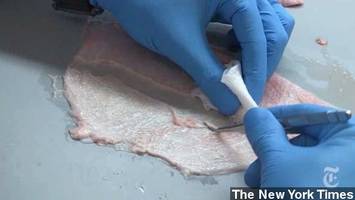 Watch VideoA new surgical technique developed by researchers at the University of Pittsburgh could help patients regrow muscle after severe accidents or injuries using a pig's bladder. If it sounds hard to believe, wait until you hear how it's done.
Watch VideoA new surgical technique developed by researchers at the University of Pittsburgh could help patients regrow muscle after severe accidents or injuries using a pig's bladder. If it sounds hard to believe, wait until you hear how it's done. Research published Wednesday details how researchers helped regrow and strengthen damaged leg muscles in five wounded patients, two of them military veterans, using that pig bladder as a sort of cellular fertilizer. (Via U.S. Army)
https://www.flickr.com/photos/soldiersmediacenter/1148977208/in/photolist-4RRJr4-53VZPE-53VZRG-4NC1KR-2KwNTS-NNUMD-igHZrP-6vqvuW-bRViyR-4K5ixF-Fq4ah-4NC1K6-4CAi3b-3EgR4Z
https://www.flickr.com/photos/soldiersmediacenter/13978732623/
In a news release on the University of Pittsburgh Medical Center website, lead researcher Stephen F. Badylak explained the body can't regenerate skeletal muscle tissue when a significant amount is lost, mainly due to trauma. He added, *"These are patients who can’t walk anymore, can’t get out of a car, can’t get up and down from a chair, can’t take steps without falling."*
http://www.upmc.com/media/NewsReleases/2014/Pages/pitt-mcgowan-study-shows-regnerative-medicine-improves-muscle-leg-function.aspx
Instead of new muscle, scar tissue forms where the injury occurred. According to Badylak, that impairs strength and function. But the team saw the use of a pig's bladder as an extracelluar matrix, or ECM, to turn things around for those wounded patients.
*"ECM consists mainly of proteins and helps keep cells in their proper place in an organ or tissue."*
Badylak: *"Extracellular — outside of the cell — material is loaded with information that tells cells what to do." *
http://www.nytimes.com/video/health/research/100000001773152/extracellular-matrix.html
As The Verge explains, the ECM attracts new stem cells to it and the healthy tissue at the site of the injury. The next step is aggressive physical therapy one to two days after surgery.
http://www.theverge.com/2014/4/30/5665910/five-humans-regenerate-muscle-through-pig-implant-procedure
The immediate physical therapy degrades the ECM and helps grow muscle cells and new tissue.
https://www.flickr.com/photos/collinox/6735354807/in/photolist-bgbsk2-9a5BbJ-2MXfJo-9hHav7-5o4ujx-4XCFFn-4EpUEH-5EQbzF-4XCFkx-ap32QW-bqQcJS-7B3ZZS-exAbJv-rA8PX-9KWTRL-ddjvKD-2n7Xh8-2JatQY-fcJ7L9-8uvV9Q-56Q2M1-52rkw-9HkPZw-anamK6-52rkg-414sns-6BfUy-7B2jQu-8GDrjv-7GQDUr-3WZau6-bGicFF-5vUmdz-bj1jJR-fKdSZV-essRCu-4Ku5ux-dmC4V1-7vUGL7-deXZhr-7KTf9j-bKeK1i-fHQssa-duTeoM-dzVkY-fXAa7S-5ANcRc-duTeqF-4XdjXc-9zFNu5
All five patients in this study had lost 58-90 percent of muscle in their legs. All patients reported an improvement in quality of life, but three of the five saw a 25 percent improvement in function to the injured limp.
https://www.youtube.com/watch?v=EOM4epIdw4k&feature=youtu.be
The Pittsburgh Post-Gazette reports although this surgical technique to regrow human muscle is new, Badylak has used organ matrices before to regenerate *"new human esophagi, patches for hernias, as well as ligaments and other body parts."*
http://www.post-gazette.com/news/health/2014/04/30/Scientists-find-way-to-grow-new-muscle-in-injured-patients/stories/201404300176#ixzz30PGRVnYG
Badylak said he hopes to test more patients with more recent injuries. He also told The New York Times he hopes this treatment will become standard for people who've suffered similar significant muscle loss.
The study was funded by the Department of Defense and is published in the journal Science Translational Medicine. Reported by Newsy 4 hours ago.